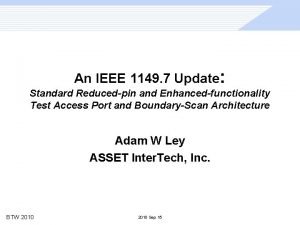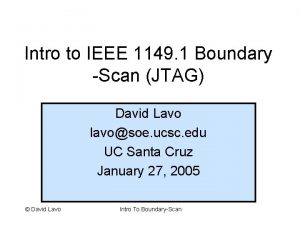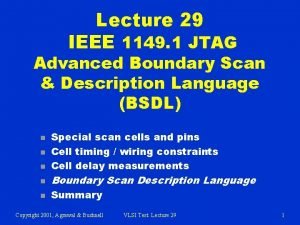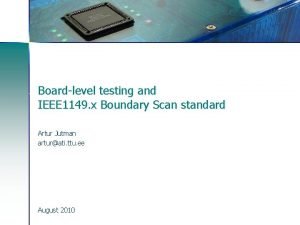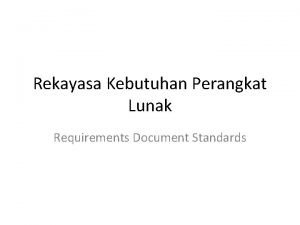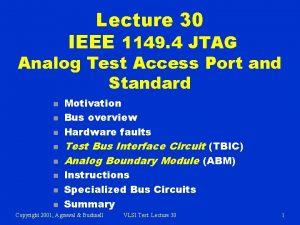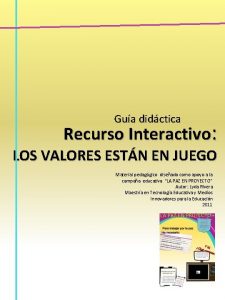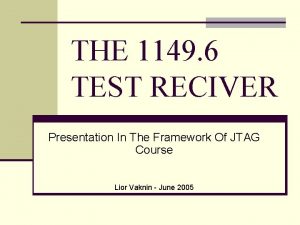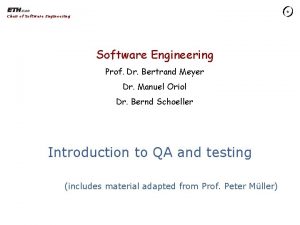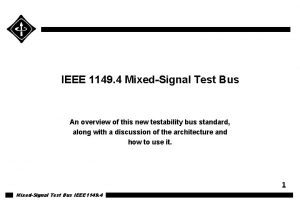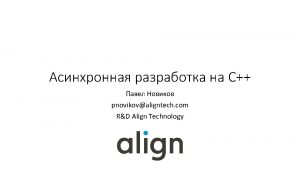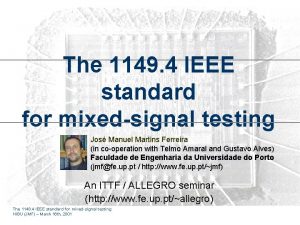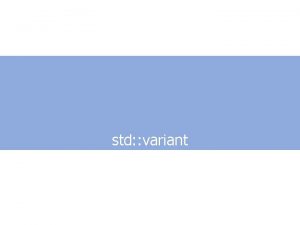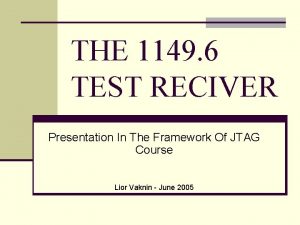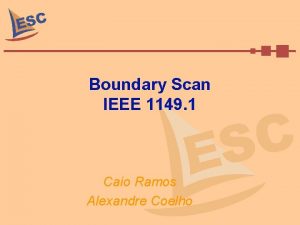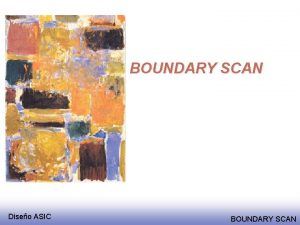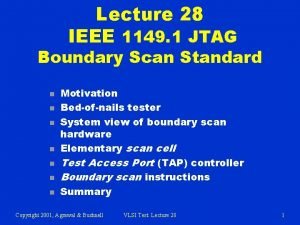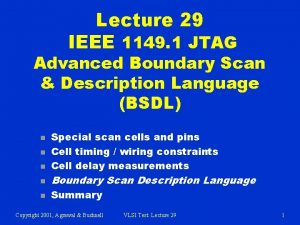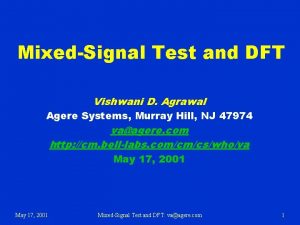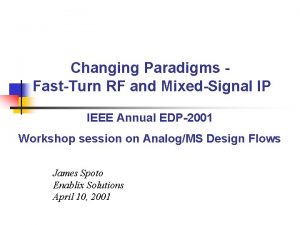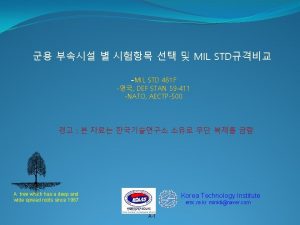The IEEE 1149 4 std for mixedsignal test























































![Experiment #2 (observe A 0 at AT 2): SVF code ABM[A 0]: SD + Experiment #2 (observe A 0 at AT 2): SVF code ABM[A 0]: SD +](https://slidetodoc.com/presentation_image_h2/d85483f56be0a862cf639bd4304bd02c/image-56.jpg)


![Experiment #3: Measuring R [A 0 -GND] (SVF code) ABM[A 0]: SB 1 + Experiment #3: Measuring R [A 0 -GND] (SVF code) ABM[A 0]: SB 1 +](https://slidetodoc.com/presentation_image_h2/d85483f56be0a862cf639bd4304bd02c/image-59.jpg)

- Slides: 60

The IEEE 1149. 4 std for mixedsignal test J. M. Martins Ferreira FEUP / DEEC - Rua Dr. Roberto Frias 4200 -537 Porto - PORTUGAL Tel. 351 225 081 748 / Fax: 351 225 081 443 (jmf@fe. up. pt / http: //www. fe. up. pt/~jmf) Introduction to design for test techniques – The IEEE 1149. 4 std for mixed-signal test © J. M. Martins Ferreira - University of Porto (FEUP / DEEC) 1

The IEEE 1149. 4 standard for mixed signal test • The 1149. 4 std defines an extension to 1149. 1, to which it adds: – An analog test port (ATAP) with two pins (AT 1, AT 2) – An internal analog test bus (AB 1, AB 2) – A test bus interface circuit (TBIC) – The analog boundary modules (ABM) Introduction to design for test techniques – The IEEE 1149. 4 std for mixed-signal test © J. M. Martins Ferreira - University of Porto (FEUP / DEEC) 2

IEEE 1149. 4: The TBIC and the ABMs • Interconnect and parametric tests can be carried out through the ABMs • Analog test signals may be routed from / to the analog pins to / from the ATAP through the TBIC and the ABMs • The TBIC and the ABM comprise a switching structure and a control structure Introduction to design for test techniques – The IEEE 1149. 4 std for mixed-signal test © J. M. Martins Ferreira - University of Porto (FEUP / DEEC) 3

The test bus interface circuit (TBIC) • The TBIC defines the interconnections between the ATAP (AT 1 and AT 2) and the internal analog test bus (at least two lines, AB 1 and AB 2) • The TBIC comprises a switching structure and a control structure Introduction to design for test techniques – The IEEE 1149. 4 std for mixed-signal test © J. M. Martins Ferreira - University of Porto (FEUP / DEEC) 4

TBIC: The switching structure Introduction to design for test techniques – The IEEE 1149. 4 std for mixed-signal test © J. M. Martins Ferreira - University of Porto (FEUP / DEEC) 5

TBIC: Switching structure patterns Main testing conditions Introduction to design for test techniques – The IEEE 1149. 4 std for mixed-signal test © J. M. Martins Ferreira - University of Porto (FEUP / DEEC) 6

assignments for defined instructions (TBIC) Introduction to design for test techniques – The IEEE 1149. 4 std for mixed-signal test © J. M. Martins Ferreira - University of Porto (FEUP / DEEC) 7

TBIC: Control structure Introduction to design for test techniques – The IEEE 1149. 4 std for mixed-signal test © J. M. Martins Ferreira - University of Porto (FEUP / DEEC) 8

The analog boundary modules (ABM) • The ABMs in the analog pins extend the test functions made available by the DBMs • All test operations combine digital (via TAP) and analog test “vectors” (via ATAP) • Each ABM comprises a switching structure and a control structure Introduction to design for test techniques – The IEEE 1149. 4 std for mixed-signal test © J. M. Martins Ferreira - University of Porto (FEUP / DEEC) 9

ABMs: Switching structure Introduction to design for test techniques – The IEEE 1149. 4 std for mixed-signal test © J. M. Martins Ferreira - University of Porto (FEUP / DEEC) 10

ABMs: Switching structure patterns (1) Main testing conditions for analog measurements Introduction to design for test techniques – The IEEE 1149. 4 std for mixed-signal test © J. M. Martins Ferreira - University of Porto (FEUP / DEEC) 11

ABMs: Switching structure patterns (2) Normal mission mode; pin connected to core only. Introduction to design for test techniques – The IEEE 1149. 4 std for mixed-signal test © J. M. Martins Ferreira - University of Porto (FEUP / DEEC) 12

ABMs: Switching pattern requirements Introduction to design for test techniques – The IEEE 1149. 4 std for mixed-signal test © J. M. Martins Ferreira - University of Porto (FEUP / DEEC) 13

ABMs: Control structure Introduction to design for test techniques – The IEEE 1149. 4 std for mixed-signal test © J. M. Martins Ferreira - University of Porto (FEUP / DEEC) 14

The 1149. 4 register structure • The 1149. 4 register structure is entirely digital and identical to the corresponding 1149. 1 structure Introduction to design for test techniques – The IEEE 1149. 4 std for mixed-signal test © J. M. Martins Ferreira - University of Porto (FEUP / DEEC) 15

The PROBE instruction • The IEEE 1149. 4 std defines a fourth mandatory instruction called PROBE: – The selected data register is the BS register – One or both of the ATAP pins connect to the corresponding AB 1/AB 2 internal test bus lines – Analog pins connect to the core and to AB 1/AB 2 as defined by the ABM 4 -bit control word – Each DBM operates in transparent mode Introduction to design for test techniques – The IEEE 1149. 4 std for mixed-signal test © J. M. Martins Ferreira - University of Porto (FEUP / DEEC) 16

Analog test operations • Principle of operation: – The analog signal is applied to AT 1 and the analog response is observed in AT 2 – With AT 1 connected to AB 1, the analog signal may be routed to the internal circuitry or to an analog output pin – Analog responses from the internal circuitry or from an analog input pin are routed to AB 2, and observed in AT 2 Introduction to design for test techniques – The IEEE 1149. 4 std for mixed-signal test © J. M. Martins Ferreira - University of Porto (FEUP / DEEC) 17

Observability of analog (input / output) pins • The signal present at any analog (input / output) pin may be observed at AT 2, with (or without) the core connected to the pin Introduction to design for test techniques – The IEEE 1149. 4 std for mixed-signal test © J. M. Martins Ferreira - University of Porto (FEUP / DEEC) 18

Controllability of analog (input / output) pins • The signal present at any analog (input / output) pin may be driven from AT 1, regardless of the signal present at the analog input Introduction to design for test techniques – The IEEE 1149. 4 std for mixed-signal test © J. M. Martins Ferreira - University of Porto (FEUP / DEEC) 19

Impedance measurement between pin and ground ZD = VT / IT if: • ZV >> ZS 6 + ZSB 2 • ZV + ZS 6 + ZSB 2 >> ZD IT ZD VT V Introduction to design for test techniques – The IEEE 1149. 4 std for mixed-signal test © J. M. Martins Ferreira - University of Porto (FEUP / DEEC) 20

Interconnect testing with 1149. 4 VH ? VL Introduction to design for test techniques – The IEEE 1149. 4 std for mixed-signal test © J. M. Martins Ferreira - University of Porto (FEUP / DEEC) 21

Functional description of a basic “ 1149. 4 component” • The core circuitry is restricted to – A voltage follower – A logic inverter • The required 1149. 4 infrastructure should only support the mandatory instructions Introduction to design for test techniques – The IEEE 1149. 4 std for mixed-signal test © J. M. Martins Ferreira - University of Porto (FEUP / DEEC) 22

Summary description of the 1149. 4 infrastructure • Instruction codes (8 -bit): – EXTEST: $00 – SAMPLE / PRELOAD: $02 – PROBE: $01 – BYPASS: $FF • Boundary scan register (TDI-TDO, 14 -bit): – TBIC (4 -bit), ABM analog input (4 -bit), ABM analog output (4 -bit), DBM digital input (1 -bit), DBM digital output (1 -bit) Introduction to design for test techniques – The IEEE 1149. 4 std for mixed-signal test © J. M. Martins Ferreira - University of Porto (FEUP / DEEC) 23

Implementation details • The digital test infrastructure and core logic was implemented by Dr. Gustavo Alves in an EPM 7128 Altera PLD (2, 500 usable gates, 128 macrocells, 84 pin PLCC) • All remaining blocks are implemented using discrete components (ADG 452 + MAX 4512 analog switches, LM 311 comparators, TL 081 Op. Amp) Introduction to design for test techniques – The IEEE 1149. 4 std for mixed-signal test © J. M. Martins Ferreira - University of Porto (FEUP / DEEC) 24

“ 1149. 4 component”: the digital test infrastructure Introduction to design for test techniques – The IEEE 1149. 4 std for mixed-signal test © J. M. Martins Ferreira - University of Porto (FEUP / DEEC) 25

Altera’s design environment (Max+plus II Baseline) Introduction to design for test techniques – The IEEE 1149. 4 std for mixed-signal test © J. M. Martins Ferreira - University of Porto (FEUP / DEEC) 26

Example description (ABM) Introduction to design for test techniques – The IEEE 1149. 4 std for mixed-signal test © J. M. Martins Ferreira - University of Porto (FEUP / DEEC) 27

ABM: the control structure TITLE " ABM control register "; SUBDESIGN ABM_CR ( TDI, TCK, en_clk. DR, shift, en_upt. DR, pin_comp : INPUT; TDO, D, C, B 1, B 2 : OUTPUT; ) (. . . ) IF ( !en_clk. DR ) THEN DATA = DATA ; CONTROL = CONTROL ; BUS 1 = BUS 1 ; BUS 2 = BUS 2 ; ELSIF ( !shift ) THEN DATA = pin_comp; % Capture % CONTROL = GND; BUS 1 = GND; BUS 2 = GND; ELSE DATA = TDI; % Shift % CONTROL = DATA; BUS 1 = CONTROL; BUS 2 = BUS 1; END IF; TDO = BUS 2; Introduction to design for test techniques – The IEEE 1149. 4 std for mixed-signal test © J. M. Martins Ferreira - University of Porto (FEUP / DEEC) IF ( !en_upt. DR ) THEN D_LATCH = D_LATCH ; C_LATCH = C_LATCH ; B 1_LATCH = B 1_LATCH ; B 2_LATCH = B 2_LATCH ; ELSE D_LATCH = DATA; % SHIFT -> LATCH -update % C_LATCH = CONTROL ; B 1_LATCH = BUS 1 ; B 2_LATCH = BUS 2 ; END IF; D = D_LATCH. q ; C = C_LATCH. q ; B 1 = B 1_LATCH. q ; B 2 = B 2_LATCH. q ; END; 28

ABM: the switching structure decoder BEGIN TABLE M 1, M 2, D, C, B 1, B 2 => SD, SH, SC, SG, SB 1, SB 2 ; 1, 1, 0, 0 => 0, 0, 0, 0 ; % p 0 - Completely isolated (CD state) % 1, 1, 0, 0, 0, 1 => 0, 0, 0, 1 ; % p 1 - Monitored by AB 2 % 1, 1, 0, 0, 1, 0 => 0, 0, 1, 0 ; % p 2 - Connected to AB 1 % 1, 1, 0, 0, 1, 1 => 0, 0, 1, 1 ; % p 3 - Connected to AB 1; monitored by AB 2 % (. . . ) 1, 1, 1, 1 => 0, 1, 0, 0, 1, 1 ; % p 15 - Connected to VH and AB 1; monitored by AB 2 % 0, 1, 0, 0 => 1, 0, 0, 0 ; % p 16 - Connected to core; isolated from all test circuits % 0, 1, 0, 0, 0, 1 => 1, 0, 0, 1 ; % p 17 - Connected to core; monitored by AB 2 % 0, 1, 0, 0, 1, 0 => 1, 0, 0, 0, 1, 0 ; % p 18 - Connected to core and AB 1 % 0, 1, 0, 0, 1, 1 => 1, 0, 0, 0, 1, 1 ; % p 19 - Connected to core and AB 1; monitored by AB 2 % 0, 1, 1, X, X, X => 1, 0, 0, 0 ; % p 16 - Clause 6 - page 74 % 0, 1, X, X => 1, 0, 0, 0 ; % p 16 - Clause 6 - page 74 % 0, 0, X, X => 1, 0, 0, 0 ; % p 16 - Clause 4 - page 74 % 1, 0, X, X => 0, 0, 0, 0 ; % p 0 - Clause 3 - page 74 % END TABLE; Introduction to design for test techniques – The IEEE 1149. 4 std for mixed-signal test © J. M. Martins Ferreira - University of Porto (FEUP / DEEC) 29

“ 1149. 4 component”: the TBIC switching structure Introduction to design for test techniques – The IEEE 1149. 4 std for mixed-signal test © J. M. Martins Ferreira - University of Porto (FEUP / DEEC) 30

“ 1149. 4 component”: the ABMs switching structure Introduction to design for test techniques – The IEEE 1149. 4 std for mixed-signal test © J. M. Martins Ferreira - University of Porto (FEUP / DEEC) 31

An “ 1149. 4 component”: wire wrapping prototype Introduction to design for test techniques – The IEEE 1149. 4 std for mixed-signal test © J. M. Martins Ferreira - University of Porto (FEUP / DEEC) 32

An “ 1149. 4 component”: printed circuit board Selection of VTH (internal / external) Notes: 1) The ABM comparator inputs in this board differ from the standard (VTH is connected to the + input). 2) VG / VTH may be applied externally (internal value of VG is 0 V) Selection of VG (internal / Introduction to design for test techniques – The IEEE 1149. 4 std for mixed-signal test external) © J. M. Martins Ferreira - University of Porto (FEUP / DEEC) 33

Proposed experiments: observability + controllability • Two experiments will be demonstrated using the wire-wrapping “ 1149. 4 component”: – The waveform at the analog output pin will be observed at AT 2, when the analog input is driven by a sine wave – The waveform at the analog output pin will be driven from AT 1 (a square wave), instead of the sine wave coming from the internal circuitry Introduction to design for test techniques – The IEEE 1149. 4 std for mixed-signal test © J. M. Martins Ferreira - University of Porto (FEUP / DEEC) 34

Observing an analog input / output pin at AT 2 • PROBE is the current instruction, the input ABM connects the pin to the core, the output ABM connects the pin to the core and to AB 2, AB 2 is connected to AT 2 Introduction to design for test techniques – The IEEE 1149. 4 std for mixed-signal test © J. M. Martins Ferreira - University of Porto (FEUP / DEEC) 35

Observability test code segment • Recommendation: Write the JTAGer test segment enabling the observability of the analog output as shown at right AN_IN AN_OUT AT 1 AT 2 Introduction to design for test techniques – The IEEE 1149. 4 std for mixed-signal test © J. M. Martins Ferreira - University of Porto (FEUP / DEEC) 36

Observability test code (demo component) ! Observability demo using the 1149. 4 component start: Before the seltap 0; breakpoint rst; state irshift; ld cnt, 8 d; ! IR has 8 bits nshfcp 40 h, 80 h, C 0 h; ! Instr. S/P and infra-structure check jerr tap-error; ! Abort test in case of TAP error state drshift; ld cnt, 14 d; ! 4 TBIC + 2 x 4 ABMs + 1 DBM nshf 2020 h; ! 0001(TBIC)- 0000(ABMin)- 0001(ABMout)- 00(DBMs) state irshift; ld cnt, 8 d; nshf 80 h; ! Instr. PROBE After the tms 1; << Breakpoint breakpoint ! Update-IR end: halt; ! Stop here if everything is OK tap-error: halt; ! Stop here if the TAP is faulty Introduction to design for test techniques – The IEEE 1149. 4 std for mixed-signal test © J. M. Martins Ferreira - University of Porto (FEUP / DEEC) 37

Controlling an analog output pin from AT 1 • EXTEST is the current instruction, the input ABM disconnects the pin from the core, the output ABM disconnects the pin from the core and connects it to AB 1, AB 1 connects to AT 1 Introduction to design for test techniques – The IEEE 1149. 4 std for mixed-signal test © J. M. Martins Ferreira - University of Porto (FEUP / DEEC) 38

Controllability test code segment • Recommendation: Write the JTAGer test segment enabling the controllability (plus observability) of the analog output as shown at right AN_IN AN_OUT AT 1 AT 2 Introduction to design for test techniques – The IEEE 1149. 4 std for mixed-signal test © J. M. Martins Ferreira - University of Porto (FEUP / DEEC) 39

Video-demos: Observability and controllability Introduction to design for test techniques – The IEEE 1149. 4 std for mixed-signal test © J. M. Martins Ferreira - University of Porto (FEUP / DEEC) (the wmv and bst files are stored in the hibu 2 k 4misc folder) 40

The STA 400 (1149. 4 analog test access device) • Features (from the data sheet): – Compliant to IEEE 1149. 1 & 1149. 4 – Analog mux / demux either dual 2: 1 or single 4: 1 – Samples up to 9 analog test points – Includes CLAMP and HIGHZ instructions – TRST input – Input range from -0, 5 V to +6, 5 V Introduction to design for test techniques – The IEEE 1149. 4 std for mixed-signal test © J. M. Martins Ferreira - University of Porto (FEUP / DEEC) 41

STA 400: Operating modes Introduction to design for test techniques – The IEEE 1149. 4 std for mixed-signal test © J. M. Martins Ferreira - University of Porto (FEUP / DEEC) 42

STA 400: Functional information • CE/CEI distinguish between the two main operating modes (analog sample, mux / demux) Introduction to design for test techniques – The IEEE 1149. 4 std for mixed-signal test © J. M. Martins Ferreira - University of Porto (FEUP / DEEC) 43

STA 400: TAP controller instructions Introduction to design for test techniques – The IEEE 1149. 4 std for mixed-signal test © J. M. Martins Ferreira - University of Porto (FEUP / DEEC) 44

STA 400: Scan chain sequence Introduction to design for test techniques – The IEEE 1149. 4 std for mixed-signal test © J. M. Martins Ferreira - University of Porto (FEUP / DEEC) 45

STA 400: Template to determine the BSR contents 1 - Instruction 2 - ABMs: Switches, switching pattern, control word 3 - TBIC: Switches, switching pattern, control word Introduction to design for test techniques – The IEEE 1149. 4 std for mixed-signal test © J. M. Martins Ferreira - University of Porto (FEUP / DEEC) 4 - BS contents: 46

Demonstration board #1: Stand-alone STA 400 0 CEI 1 CE A AT 1 Notes: 1) The internal 7805 generates the +5 V power supply 2) The operating mode is selected via a set of builtin jumpers 0 C 1 0 C 0 0 M ATAP connections The built-in current source is adjustable JTAGercompatible TAP connections +12 V / GND power supply Introduction to design for test techniques – The IEEE 1149. 4 std for mixed-signal test © J. M. Martins Ferreira - University of Porto (FEUP / DEEC) is 0, is 1 SCANSTA 4 00 analog I/O pins 47

Demonstration board #2: STA 400 and BCT 8244 • The STA 400 and the BCT 8244 are in the same chain • The BCT 8244 is able to control the STA 400 • Parametric and functional tests are possible Introduction to design for test techniques – The IEEE 1149. 4 std for mixed-signal test © J. M. Martins Ferreira - University of Porto (FEUP / DEEC) 48

Schematic diagram +12 V Iout 7805 +5 V 0 V VCC 1 24 2 Y 3 2 Y 2 2 Y 1 1 Y 4 2 Y 4 10 VCC 18 2 A 4 9 2 Y 3 8 2 Y 2 2 Y 1 7 2 A 3 13 TCK 5 2 A 2 12 TMS 4 1 Y 4 14 TDI 3 1 Y 3 SN 74 BCT 8244 2 2 A 1 TCK STA 400 1 A 4 TMS GND +5 V 1 A 3 TDI +5 V 18 1 Y 2 15 12 13 14 1 Y 3 3 1 A 2 GND C 1 C 0 TMS AT 1 TCK AT 2 TDI TDO A 0 A 1 A 2 A 3 0 V 2 1 Y 1 0 V MODE TDI 10 CEI 1 4 2 5 4 1 A 1 8 /TRST A 0 A 1 A 2 A 3 /2 OE 11 CE Prototyping area /1 OE 16 VCC AT 1 9 AT 2 7 TCK TDO 6 TMS 20 A 01 A 23 19 17 +5 V GND 6 TDO 11 23 22 21 20 19 17 16 15 +5 V 0 V Introduction to design for test techniques – The IEEE 1149. 4 std for mixed-signal test © J. M. Martins Ferreira - University of Porto (FEUP / DEEC) DIP switches 0 V 49

+12 V GND A 23 A 01 AT 2 AT 1 I out Demonstration board #2 Adjustable current source DIP switches that control the BCT 8244 octal outputs A 0 A 2 A 1 A 3 CE GND National Semiconductor SCANSTA 400 JTAG port Prototyping area: Connectors and space available for add-on boards SN 74 BCT 8244 BST octal (TI SCOPE family) Introduction to design for test techniques – The IEEE 1149. 4 std for mixed-signal test © J. M. Martins Ferreira - University of Porto (FEUP / DEEC) TDO TMS TDI TCK 50

Add-on boards Introduction to design for test techniques – The IEEE 1149. 4 std for mixed-signal test © J. M. Martins Ferreira - University of Porto (FEUP / DEEC) 51

Experiment #1: Control A 01 via the BCT 8244 scan octal STA 400 s: sine A 0 p: pulse A 1 BCT 8244 A 01 s/p C 0 DIP switch 1 Y 1 TDI Introduction to design for test techniques – The IEEE 1149. 4 std for mixed-signal test © J. M. Martins Ferreira - University of Porto (FEUP / DEEC) TDO 52

Experiment #1: Control A 01 via 1 Y 1 (SVF code) Set 1 Y 1 to 0 (A 01 A 0 at EXTEST in BCT 8244) STA 400 A 1 BCT 8244 A 01 s/p C 0 TDI Introduction to design for test techniques – The IEEE 1149. 4 std for mixed-signal test © J. M. Martins Ferreira - University of Porto (FEUP / DEEC) 1 Y 1 TDO 53

1 Y 1 (BCT 8244) A 01 (STA 400) Introduction to design for test techniques – The IEEE 1149. 4 std for mixed-signal test © J. M. Martins Ferreira - University of Porto (FEUP / DEEC) 54

Experiment #2: Functional test (observe A 0 at AT 2) STA 400 s: sine A 0 p: pulse A 1 BCT 8244 A 01 s/p DIP switch AT 2 TDI Introduction to design for test techniques – The IEEE 1149. 4 std for mixed-signal test © J. M. Martins Ferreira - University of Porto (FEUP / DEEC) TDO 55
![Experiment 2 observe A 0 at AT 2 SVF code ABMA 0 SD Experiment #2 (observe A 0 at AT 2): SVF code ABM[A 0]: SD +](https://slidetodoc.com/presentation_image_h2/d85483f56be0a862cf639bd4304bd02c/image-56.jpg)
Experiment #2 (observe A 0 at AT 2): SVF code ABM[A 0]: SD + SB 2 on TBIC: S 6 + S 9 on STA 400 A 1 BCT 8244 A 01 s/p AT 2 TDI Introduction to design for test techniques – The IEEE 1149. 4 std for mixed-signal test © J. M. Martins Ferreira - University of Porto (FEUP / DEEC) TDO 56

AT 2 (STA 400) Introduction to design for test techniques – The IEEE 1149. 4 std for mixed-signal test © J. M. Martins Ferreira - University of Porto (FEUP / DEEC) 57

Experiment #3: Parametric testing (R=? ) STA 400 BCT 8244 R=? A 0 A 1 A 01 Volt AT 2 Amp TDI I DIP switch AT 1 TDO + Introduction to design for test techniques – The IEEE 1149. 4 std for mixed-signal test © J. M. Martins Ferreira - University of Porto (FEUP / DEEC) 58
![Experiment 3 Measuring R A 0 GND SVF code ABMA 0 SB 1 Experiment #3: Measuring R [A 0 -GND] (SVF code) ABM[A 0]: SB 1 +](https://slidetodoc.com/presentation_image_h2/d85483f56be0a862cf639bd4304bd02c/image-59.jpg)
Experiment #3: Measuring R [A 0 -GND] (SVF code) ABM[A 0]: SB 1 + SB 2 on TBIC: S 5 + S 6 on STA 400 BCT 8244 R=? A 0 A 1 A 01 Volt AT 2 Amp TDI I AT 1 + Introduction to design for test techniques – The IEEE 1149. 4 std for mixed-signal test © J. M. Martins Ferreira - University of Porto (FEUP / DEEC) 59

(R to be measured is 1 K 2) Introduction to design for test techniques – The IEEE 1149. 4 std for mixed-signal test © J. M. Martins Ferreira - University of Porto (FEUP / DEEC) 60
 Ieee1149
Ieee1149 Ieee 1149
Ieee 1149 Ieee1149
Ieee1149 1149 x 24
1149 x 24 Ieee 829 ejemplo
Ieee 829 ejemplo Ieee standard 829
Ieee standard 829 Ieee830 テンプレート
Ieee830 テンプレート Sba low doc eligibility checklist
Sba low doc eligibility checklist Analog test bus
Analog test bus Unicef/hq03-1149/senad
Unicef/hq03-1149/senad 1149/6
1149/6 Engineers test idea for new
Engineers test idea for new Iso 22301 utbildning
Iso 22301 utbildning Typiska novell drag
Typiska novell drag Nationell inriktning för artificiell intelligens
Nationell inriktning för artificiell intelligens Returpilarna
Returpilarna Varför kallas perioden 1918-1939 för mellankrigstiden
Varför kallas perioden 1918-1939 för mellankrigstiden En lathund för arbete med kontinuitetshantering
En lathund för arbete med kontinuitetshantering Kassaregister ideell förening
Kassaregister ideell förening Tidbok för yrkesförare
Tidbok för yrkesförare A gastrica
A gastrica Densitet vatten
Densitet vatten Datorkunskap för nybörjare
Datorkunskap för nybörjare Tack för att ni lyssnade bild
Tack för att ni lyssnade bild Debatt artikel mall
Debatt artikel mall För och nackdelar med firo
För och nackdelar med firo Nyckelkompetenser för livslångt lärande
Nyckelkompetenser för livslångt lärande Påbyggnader för flakfordon
Påbyggnader för flakfordon Tryck formel
Tryck formel Publik sektor
Publik sektor I gullregnens månad
I gullregnens månad Presentera för publik crossboss
Presentera för publik crossboss Argument för teckenspråk som minoritetsspråk
Argument för teckenspråk som minoritetsspråk Kanaans land
Kanaans land Klassificeringsstruktur för kommunala verksamheter
Klassificeringsstruktur för kommunala verksamheter Mjälthilus
Mjälthilus Bästa kameran för astrofoto
Bästa kameran för astrofoto Centrum för kunskap och säkerhet
Centrum för kunskap och säkerhet Verifikationsplan
Verifikationsplan Mat för unga idrottare
Mat för unga idrottare Verktyg för automatisering av utbetalningar
Verktyg för automatisering av utbetalningar Rutin för avvikelsehantering
Rutin för avvikelsehantering Smärtskolan kunskap för livet
Smärtskolan kunskap för livet Ministerstyre för och nackdelar
Ministerstyre för och nackdelar Tack för att ni har lyssnat
Tack för att ni har lyssnat Vad är referatmarkeringar
Vad är referatmarkeringar Redogör för vad psykologi är
Redogör för vad psykologi är Stål för stötfångarsystem
Stål för stötfångarsystem Atmosfr
Atmosfr Borra hål för knoppar
Borra hål för knoppar Vilken grundregel finns det för tronföljden i sverige?
Vilken grundregel finns det för tronföljden i sverige? Formel standardavvikelse
Formel standardavvikelse Tack för att ni har lyssnat
Tack för att ni har lyssnat Rita perspektiv
Rita perspektiv Verksamhetsanalys exempel
Verksamhetsanalys exempel Tobinskatten för och nackdelar
Tobinskatten för och nackdelar Toppslätskivling dos
Toppslätskivling dos Gibbs reflekterande cykel
Gibbs reflekterande cykel Egg för emanuel
Egg för emanuel Elektronik för barn
Elektronik för barn Plagg i rom
Plagg i rom
